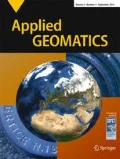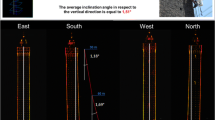Abstract
Monitoring the movement of structures on railway projects in the UK typically involves the fixing of targets (e.g. prisms) or sensors onto the structures being monitored and their surroundings. Whilst this provides discrete point measurement capability across the structure, it is highly intrusive and expensive to setup in a railway environment. Terrestrial laser scanning (TLS) has become an invaluable method of data capture within the surveying industry including applications such as deformation monitoring. The main advantages of TLS, as opposed to other surveying techniques, are the ability to capture large volumes of 3D data at high speed, remotely and with a reasonably high accuracy. A complimentary technique, close-range photogrammetry (CRP), has been traditionally applied to structural monitoring, but is not routinely considered by the railway monitoring community. This technique has the advantage of rapid data capture from a mobile camera with the capability to monitor single points or to generate a point cloud, with an equipment cost approximately twenty times cheaper than a TLS system and at about one tenth the cost of a single instrument total station approach. This paper describes the application of TLS and CRP, along with conventional survey techniques, to the monitoring of a set of masonry arches during a major station refurbishment. Firstly, it investigates the capabilities of using TLS compared to traditional survey methods and encompasses a case where significant movements occur over an extended period of time. Inter-epoch comparison demonstrates a capability to detect change but highlights a requirement to understand the structure and data quality in making valid interpretations. Secondly, the paper compares TLS and CRP techniques as monitoring tools for creating point cloud data on the same set of masonry arches. These investigations generate significant volumes of data conferring the additional challenge of how to visualise observed changes and communicate those changes and their significance to the engineers who must make informed decisions from the data in a timely fashion.












Similar content being viewed by others
Notes
References
Abellán A, Jaboyedoff M et al (2009) Detection of millimetric deformation using a terrestrial laser scanner: experiment and application to a rockfall event. Nat Hazards Earth Syst Sci 9(2):365–372
Abellán A, Vilaplana J et al (2011) Rockfall monitoring by terrestrial laser scanning–case study of the basaltic rock face at castellfollit de la Roca (Catalonia, Spain). Nat Hazards Earth Syst Sci 11(3):829–841
Alba M. and Scaioni M (2010) Automatic detection of changes and deformation in rock faces by terrestrial laser scanning. Proceedings of the ISPRS Commission V Mid-Term Symposium ‘Close Range Image Measurement Techniques
Alba, M., L. Fregonese, et al. (2006). Structural monitoring of a large dam by terrestrial laser scanning. Proceedings of of the ISPRS Commission V Symposium, Dresden.
Allan AL (2007) Principles of geospatial surveying, Whittles Pub
Baltsavias EP (1991) Multiphoto geometrically constrained matching, ETH Zurich, Switzerland
Besl PJ, McKay ND (1992) A method for registration of 3-D shapes. IEEE Trans Pattern Anal Mach Intell 14(2):239–256
Chow J, Lichti D et al (2012) "Accuracy assessment of the faro focus3D and leica HDS6100 panoramic type terrestrial laser scanner through point-based and plane-based user self-calibration." Proceedings of the FIG Working Week: Knowing to Manage the Territory, Protect the Environment, Evaluate the Cultural Heritage, Rome, Italy: 6-10
Erdélyi J, Kopáčik A, Ilkovičová Ľ, Lipták I and Kajánek P (2014) Deformation Monitoring of a Parabolic Roof Structure using TLS. INGEO 2014 - 6th International Conference on Engineering Surveying. Prague, Czech Republic
FARO (2013) "FARO Focus3D: Features, Benefits & Technical Specifications." Retrieved 13 January 2014, from http://www.faro.com/products/3d-surveying/laserscanner-faro-focus-3d/overview
FARO (2014) "Faro Laser Scanners X Series." Retrieved 15 September, 2014, from http://www.faro.com/en-us/products/3d-surveying/faro-focus3d/overview
Fryer J, Parberry R et al (1992) Analysis of as-built cylindrical shapes. Aust J Geodesy, Photogramm Surv 56:91–109
Gordon SJ, Lichti D et al (2005) Structural deformation measurement using terrestrial laser scanners, Curtin University of Technology
Granshaw S (1980) Bundle adjustment methods in engineering photogrammetry. Photogramm Rec 10(56):181–207
James M, and Robson S (2012) "Straightforward reconstruction of 3D surfaces and topography with a camera: accuracy and geoscience application." Journal of Geophysical Research: Earth Surface (2003–2012) 117(F3)
Jiang R, Jáuregui DV et al (2008) Close-range photogrammetry applications in bridge measurement: literature review. Measurement 41(8):823–834
Kang Z, Tuo L et al (2012) Continuously deformation monitoring of subway tunnel based on terrestrial point clouds. Int Arch Photogramm Remote Sens Spat Inf Sci 39:199–203
Kopáčik A, Erdélyi J, Lipták I, and Kyrinovič P (2013) Deformation of Bridge Structures using TLS. 2nd Joint International Syposium in Deformation Monitoring, Univeristy of Nottingham
Laefer DF, Truong-Hong L et al (2014) Crack detection limits in unit based masonry with terrestrial laser scanning. NDT E Int 62:66–76
Leica Geosystems A (2010) "Leica Viva TS15." Data sheet, Herbrugg
Lerma García JL, Van Genechten B.et al (2008) 3D Risk Mapping. Theory and Practice on Terrestrial Laser Scanning. Training Material Based on Practical Applications, Universidad Politécnica de Valencia, Valencia
Lindenbergh R, Pfeifer N (2005) "A statistical deformation analysis of two epochs of terrestrial laser data of a lock." Proc. of Optical 3D. Meas Tech 2:61–70
Luhmann T, Robson S. et al (2013) Close-range Photogrammetry and 3D Imaging, De Gruyter
Monserrat O, Crosetto M (2008) Deformation measurement using terrestrial laser scanning data and least squares 3D surface matching. ISPRS J Photogramm Remote Sens 63(1):142–154
Nuttens T, De Wulf A et al (2010) High Resolution Terrestrial Laser Scanning for Tunnel Deformation Measurements. FIG Congress 2010: Facing the Challenges - Building the Capacity, Sydney, Australia
Nuttens T, De Wulf A et al (2012) Application of laser scanning for deformation measurements: a comparison between different types of scanning instruments. Proceedings of the FIG Working Week
Nuttens T, Stal C et al (2014) Methodology for the ovalization monitoring of newly built circular train tunnels based on laser scanning: liefkenshoek rail link (Belgium). Autom Constr 43:1–9
Olsen MJ, Kuester F et al (2009) Terrestrial laser scanning-based structural damage assessment. J Comput Civ Eng 24(3):264–272
Park H, Lee H et al (2007) A new approach for health monitoring of structures: terrestrial laser scanning. Comput Aided Civ Infrastr Eng 22(1):19–30
Puente I, González-Jorge H et al (2012) Deformation monitoring of motorway underpasses using laser scanning data. ISPRS-Int Arch Photogramm Remote Sens Spat Inf Sci 1:235–238
Reshetyuk Y (2010) Direct georeferencing with GPS in terrestrial laser scanning. Z f V-Z Geodäsie Geoinformation Landmanagement 135(3):151–159
Riegl (2014) "Riegl Laser Measurement Systems." Retrieved 15th September, 2014, from http://www.riegl.com/nc/products/terrestrial-scanning/produktdetail/product/scanner/33/
Riveiro B, Morer P et al (2011) Terrestrial laser scanning and limit analysis of masonry arch bridges. Constr Build Mater 25(4):1726–1735
Riveiro B, González-Jorge H et al (2013) Validation of terrestrial laser scanning and photogrammetry techniques for the measurement of vertical underclearance and beam geometry in structural inspection of bridges. Measurement 46(1):784–794
Schneider D (2006) Terrestrial laser scanning for area based deformation analysis of towers and water dams. Proc. of 3rd IAG/12th FIG Symp., Baden, Austria, May
Schuhmacher S, and Böhm J (2005) "Georeferencing of terrestrial laserscanner data for applications in architectural modeling"
Uren J, Price WF (2010) Surveying for engineers. Macmillan, Palgrave
Vezočnik R, Ambrožič T et al (2009) Use of terrestrial laser scanning technology for long term high precision deformation monitoring. Sensors 9(12):9873–9895
Werner T, and Morris D (2010) 3D Laser Scanning for Masonry Arch Bridges. FIG Congress 2010: Facing the Challenges - Building the Capacity, Sydney, Australia
Westoby M, Brasington J et al (2012) ‘Structure-from-Motion’ photogrammetry: a low-cost, effective tool for geoscience applications. Geomorphology 179:300–314
Yoon J-S, Sagong M et al (2009) Feature extraction of a concrete tunnel liner from 3D laser scanning data. NDT E Int 42(2):97–105
Acknowledgments
This research is based on a collaborative project funded by the EPSRC (Engineering and Physical Sciences Research Council) and Network Rail through the Virtual Environments Imaging & Visualisation (VEIV) Engineering Doctorate Centre at University College London. The authors would like to thank the survey team at Costain working on the London Bridge Redevelopment Project, in particular Dean Bain and Rob Williams, who organised access to the site and equipment as well as providing continuous support towards the study.
Author information
Authors and Affiliations
Corresponding author
Rights and permissions
About this article
Cite this article
Soni, A., Robson, S. & Gleeson, B. Structural monitoring for the rail industry using conventional survey, laser scanning and photogrammetry. Appl Geomat 7, 123–138 (2015). https://doi.org/10.1007/s12518-015-0156-1
Received:
Accepted:
Published:
Issue Date:
DOI: https://doi.org/10.1007/s12518-015-0156-1




